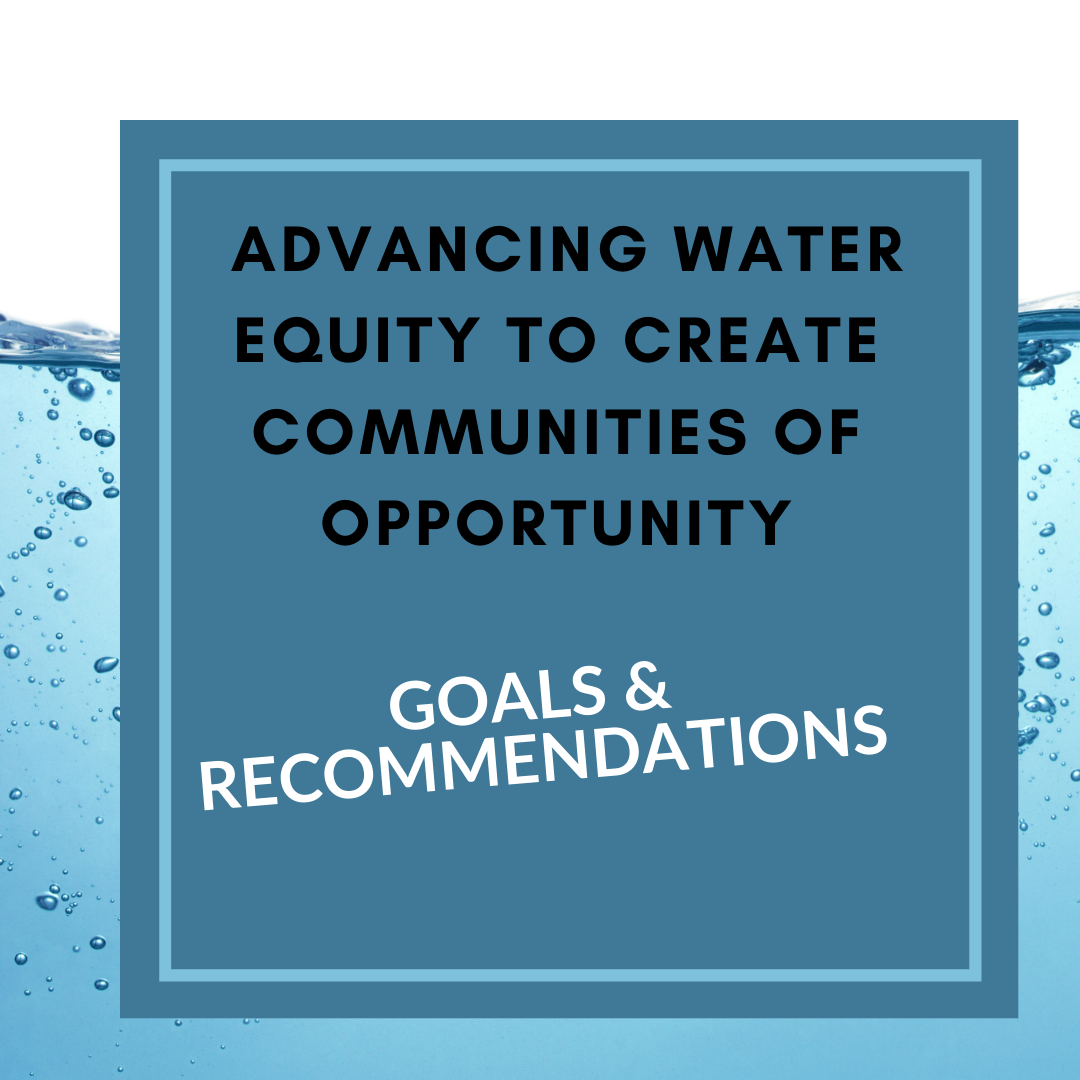Advancing Water Equity to Create Communities of Opportunity

Across the country, growing numbers of people are confronting the water threats impacting their communities. These range from rural farmworker communities in California lacking clean water due to dilapidated infrastructure and agricultural pollution; to Gulf Coast and Midwest communities experiencing climate-driven storm-related flooding and sea-level rise that forces their displacement; to urban communities facing water shutoffs and contaminated water systems that threaten their health; to Indigenous communities confronting violations by oil and gas expansion that threaten their waters, sacred spaces, and sovereign lands.
The decline of federal investment has removed a valuable funding source to support maintenance and replacement of safe drinking and wastewater systems. Cities and states are increasingly shouldering the bulk of costly maintenance and repair responsibilities established under the 1972 Clean Water Act and 1974 Safe Drinking Water Act, the premier laws protecting the health, quality, and accessibility of the country’s water. In the next few years, as much as 20 percent of the population of the US could face unaffordable water bills. And where people already face this challenge, the resulting shutoffs, home liens, and foreclosure hotspots are congruent with high incidences of Covid exposure and mortality.
Federal leaders must address three key priorities: (1) the human right and public health imperative to safe and affordable water services; (2) climate-related planning, mitigation, resilience, disaster recovery, and relocation; and (3) equitable inclusive practices in the design, build, operations, maintenance, and management of resilient water infrastructure. The restoration and expansion of clean water and safe stormwater systems should be elevated to a $500 billion authorization as a key mechanism to restore health and drive economic recovery.
Goals
- Safe and affordable drinking water for the nation’s 100 million economically vulnerable residents. ($200 billion)
- Water infrastructure investments build climate resilience and expand economic opportunities for communities of color. ($200 billion)
- Economically vulnerable communities have agency in water infrastructure policymaking processes that shape their lives. ($100 billion)
Recommendations
First 100 Days
- Issue executive order codifying the human right to water in the US.
- Provide emergency funding for affected water utilities, particularly serving disadvantaged or hardhit communities, to help offset lost revenue, the costs associated with moratoriums on shutoffs, and the essential public health protections being put in place by water utilities.
- Make water shutoff moratorium/safe reconnection provision permanent, to ensure every person in the US has access to water in their homes now and through the duration of the Covid-19 crisis and to allow relief to vulnerable customers for a time afterwards to regain their financial footing, while also providing needed fiscal support to water systems.
- Capitalize clean water and drinking water state revolving funds at the level of $400 billion in new funding over five years with at least 40 percent of the new funding distributed to disadvantaged communities as grants rather than loans. Eligibility for the affordable rate-payer funding can apply to all water systems, regardless of their organizational structure.
- Direct the EPA Administrator to maintain environmental justice data related to water. These should include: an upgraded and accessible EJ screen tool or a comparable public environmental justice mapping and screening tool that documents incidence of toxic water exposure; unaffordable water; water shut offs; climate-related flood events; and sea-level rise. Based on national environmental and demographic data, this tool is an essential part of environmental justice communities’ ability to stay informed and for the federal government to target resources to disadvantaged communities.
- Increase resilience to extreme weather events. Federal leaders should provide grants from the $400 billion over five years to cities, utilities, and nonprofits for planning and adaptation. These grants will accelerate resilience protections through Water Infrastructure Resiliency and Sustainability Grant programs, for disadvantaged communities’ water systems to natural hazards, such as intensified weather events due to climate change.
Long-Term Priorities
- Build a climate-resilient water opportunity workforce and small business ecosystem. All water infrastructure funds should require 50 percent local hire of workers from EJ communities; and 35 percent of contract dollars dedicated to procurement from contractors of color. One percent of infrastructure investments should go to programmatic support for recruitment, training, placement, and monitoring of project inclusion. Civilian Conservation Corps and Americorps should be expanded to create school-to-apprentice pathways in green storm infrastructure.
- Support a national ecosystem of workforce development, jobs for and procurement from businesses of color in Environmental Water Careers at $100 billion. The Covid-19 recession has hit communities of color especially hard, with millions of jobs and business opportunities lost. These communities also have troubled water systems with toxic exposures or water shutoffs, creating greater health risks for those exposed to long standing environmental injustices. The long-term impacts of the unprecedented spike in unemployment and the severity of the 2020 pandemic increases the demand for expanded workforce and disadvantaged business development services in the water sector, including training, career navigation, and other services that prepare and connect dislocated workers and firms with new jobs and contracts. The significant new investment in climate-resilient water infrastructure outlined in the measures above to address unsafe drinking water and climate-related flooding, sea-level rise, and drought can provide new career pathways and better public health outcomes.
- Expand four important existing programs to ensure that 50 percent of local disadvantaged workers are hired and that 35 percent of contract dollars go to people-of-color firms (see above):
- The Environmental Protection Agency Brownfields Environmental Workforce Development and Job Training grants program;
- The Environmental Health Sciences Environmental Career Worker Training program;
- Workforce Investments Opportunity Act (WIOA) investments set-asides directed at water sector employment training and low income youth (piloted in AWIA Section 4304 in 2018); and
- A 1 percent set aside of all new water infrastructure investments dedicated to the development of local ecosystems that create the pathways to onboard people-of-color workers and firms to participate in water infrastructure development (use 1 percent as grants to nonprofits, educational institutions, and unions to: recruit disadvantaged workers and firms for training; support apprenticeships; provide working capital, bonding, insurance, and monitoring to ensure proactive compliance of targets).
- The Environmental Protection Agency Brownfields Environmental Workforce Development and Job Training grants program;
Covid-19 Response
- Enact the Emergency Water is a Human Right Act which “provides funds to states and Indian tribes to assist low-income households that pay a high proportion of household income for drinking water and wastewater services. Further, any entity receiving financial assistance under this grant program must ensure that no home energy service or public water system service is or remains disconnected or interrupted during the COVID-19 (i.e., coronavirus disease 2019) public health emergency.”
- At a minimum include the $1.5 billion in water affordability funding as proposed in the HEROES Act, and ideally include $4 billion in immediate funding to the Environmental Protection Agency for grants to the states for a Low-Income Households Drinking Water and Wastewater Assistance/ Affordability Program to help struggling households pay for essential water and wastewater service.
Conclusions
To make real the promise of the human right to water and to address goals of climate resilience and water equity, any water or infrastructure policy that moves forward at state, federal, or tribal levels will include comprehensive approaches that make targeted investments in disadvantaged communities to ensure their access to safe and affordable water services; that mitigate and reverse the negative trends of climate change that are causing disruptions of drought, floods, and sea-level rise; that engage disadvantaged workers and women and people-of-color businesses; and that improve quality of life and prevent displacement for current residents of the places invested in.

